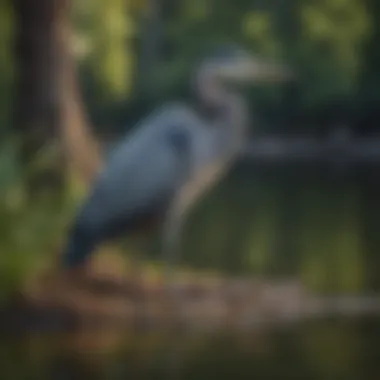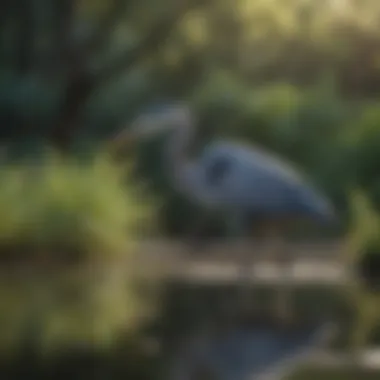The Blue Heron: Habitat, Behavior, and Conservation Insights


Overview of the Topic
The blue heron is a fascinating bird that plays a vital role in its ecosystem. Found across North America, these large, wading birds are commonly spotted in wetlands, lakes, and marshes. Understanding their habitat, behavior, and conservation status is crucial for appreciating their environmental contributions.
Blue herons not only act as indicators of wetland health but also help maintain fish populations by preying on smaller aquatic species. Research on their nesting, feeding, and migratory habits reveals insights into broader ecological patterns, making them important subjects for conservation studies.
Intro to the Key Natural Resource or Environmental Issue
One significant environmental issue surrounding blue herons is habitat loss. Wetlands, which are essential for their survival, are being drained and developed for agriculture and urban expansion. This trend negatively impacts not only herons but also countless other species reliant on these ecosystems.
Background Information on the Significance of the Topic
As apex predators, blue herons play an essential role in controlling prey populations. Their presence in a habitat often indicates a balanced ecosystem. When they thrive, it suggests that their environment is in good condition. Recognizing their value can inform preservation strategies that support both the herons and other wildlife.
Current Status and Challenges
The blue heron population has faced various challenges in recent decades. While some areas have seen stable or increasing numbers, many regions report significant declines. The primary factors include
- Habitat degradation due to urban development
- Climate change affecting breeding and feeding grounds
- Pollution leading to reduced fish populations
Examination of the Current State of the Natural Resource
Today, many heron colonies are categorized as vulnerable due to these threats. Monitoring efforts are crucial in understanding their population dynamics. Specific studies on their nesting sites provide valuable data on habitat preferences and selection.
Identification of Challenges Facing the Topic
In addition to habitat destruction, blue herons often face threats from human activity. Disturbances during nesting can lead to abandoned colonies. Additionally, pollution from agricultural runoff compromises their food sources. This multifaceted set of challenges necessitates comprehensive planning and intervention strategies.
Sustainable Solutions
Addressing the issues facing blue herons requires a combination of conservation efforts and community engagement. Successful initiatives include the restoration of wetland areas and creating protected habitats where herons can thrive. Organizations across North America work to enforce regulations aimed at preserving these crucial environments.
Exploration of Sustainable Practices and Solutions
Creating awareness through educational programs can significantly contribute to blue heron conservation. Local communities are encouraged to participate in habitat clean-up activities and monitoring programs. The collaborative approach often leads to innovative solutions tailored to specific region needs.
Showcase of Successful Case Studies
One notable example is the work done in the Chesapeake Bay area. Here, habitat restoration projects have revitalized blue heron populations. Ecologists have collaborated with local governments to implement policies that protect and restore wetlands, showing how informed action can lead to positive results.
Impact and Importance
The conservation of blue herons extends beyond their population. Their ecological role and significance in cultural contexts underscore their importance in our environment. Healthy blue heron populations indicate well-functioning ecosystems, which contribute to overall biodiversity.
Analysis of the Impact of the Topic on Ecosystems
As blue herons hunt for food, they often influence the species population in their environment. By keeping fish populations in check, they help maintain balance in aquatic ecosystems, allowing for diverse life forms to coexist.
Emphasis on the Importance of Conservation Efforts
Ongoing conservation efforts are crucial for ensuring future generations can experience the beauty of blue herons. Collective action is necessary to protect their habitats, combat pollution, and mitigate the effects of climate change. Sustained efforts can make a significant difference, securing habitats for blue herons and the ecosystems they represent.
Preamble to Blue Herons
The blue heron is a bird that has garnered significant attention not only for its stunning appearance but also for its role in the ecosystem. Understanding the blue heron is vital to comprehending broader ecological dynamics and conservation efforts. This section introduces the unique aspects of blue herons, highlighting their ecological importance and the intricate relationships they maintain within their habitats.
Defining Blue Herons
Blue herons, specifically the Great Blue Heron (Ardea herodias), are large wading birds commonly found in North America. They are characterized by their long necks, slender bodies, and striking blue-gray plumage. With a wingspan that can exceed six feet, these birds are easily distinguishable in their natural habitat. Blue herons are typically found near water sources such as lakes, rivers, and marshes. They stand still for extended periods, often hunting fish and amphibians with remarkable precision. The heron's long legs enable it to wade comfortably in shallow waters.


Importance in Ecosystems
The presence of blue herons signifies a healthy ecosystem. They serve as both predators and prey, contributing to the balance of aquatic life. By preying on fish, frogs, and various invertebrates, blue herons help regulate populations of these species. Their activities can influence the distribution of aquatic organisms and promote biodiversity. In addition, the heron's feeding habits often highlight changes in water quality and habitat conditions.
"The blue heron acts as an indicator species, reflecting the health of its environment."
Conservation of blue herons and their habitats has broader implications for ecosystem health. Their decline can signal underlying environmental problems, necessitating immediate attention. Thus, studying blue herons not only adds to our knowledge of these birds but also emphasizes the need for sustained conservation efforts.
Taxonomy and Classification
Understanding the taxonomy and classification of blue herons is fundamental to comprehending their biology, behaviors, and ecological roles. This section delineates the specific classifications within the broader avian family to which blue herons belong. Taxonomy helps scientists and conservationists alike categorize species based on shared characteristics. Such categorization provides beneficial insights into their evolutionary history, ecosystem interactions, and conservation needs. More importantly, awareness of taxonomic classification aids in the development of targeted conservation strategies. For example, recognizing distinct blue heron species can lead to effective habitat management plans.
Species Overview
Blue herons primarily encompass the species Ardea herodias, commonly known as the great blue heron. This species is substantial in size, recognized for its tall stature, long neck, and sharp beak, which are all adaptations for hunting. Other species associated with the blue heron family include the Ardea alba or great egret. While varying in color and size, these heron species share similar habitat preferences and hunting behaviors. Taxonomic classification divides them into various subspecies based on geographical location and slight morphological differences. The understanding gained through this classification contributes to effective monitoring of heron populations and informs necessary conservation actions.
Physical Characteristics
The physical characteristics of blue herons are truly remarkable and serve various functional purposes in their daily lives. A great blue heron can reach heights of up to four and a half feet, with wingspans extending around six feet. Their plumage predominantly exhibits shades of blue-gray, with a striking white head and neck. This coloration not only aids in camouflage among reeds and wetlands but also plays a role in their courtship display.
The long legs of the blue heron allow for effective wading through shallow waters while hunting for fish and amphibians. Their sharp, pointed bills are perfectly designed for their predatory lifestyle, facilitating quick strikes to catch prey. Moreover, the heron's strong musculature and skeletal structure enable them to take flight swiftly, an advantage when avoiding predators or searching for new feeding grounds. This combination of physical traits uniquely equips blue herons to thrive within their natural habitats.
Natural Habitat
The natural habitat of blue herons is crucial to their survival and overall health. These habitats provide essential resources, including food, nesting sites, and safe cover from predators. Understanding their preferred environments and geographical distribution helps to appreciate why conservation efforts are critical. Blue herons rely heavily on wetlands, marshes, and shallow water bodies, and any degradation or loss of these habitats can have dire consequences.
Preferred Environments
Blue herons thrive in various wetland ecosystems. They are commonly found in:
- Saltwater Marshes: These marshes are vital for foraging. Blue herons can hunt fish and crustaceans in these brackish waters.
- Freshwater Lakes and Ponds: Shallow edges of lakes and ponds allow herons to wade in and capture their prey.
- Rivers and Streams: Flowing water bodies provide diverse feeding options with ample fish populations.
- Estuaries: The transition areas where fresh meets saltwater are advantageous for hunting.
Each of these environments provides adequate cover and access to food, which is paramount for breeding and feeding success.
Geographical Distribution
Blue herons inhabit regions across North America, extending from the temperate zones to tropical areas. Their distribution can be summarized as follows:
- North America: Predominantly found in the continental United States and Canada.
- Migration Patterns: Many blue herons migrate south during winter, moving to warmer climates, particularly in Central America and parts of the Caribbean.
- Specific Locations: Notable concentrations exist in places like the Florida Everglades, Chesapeake Bay, and the San Francisco Bay wetlands. These areas not only support large heron populations but also serve as critical locations for breeding.
The positioning of blue herons within these geographical zones underscores their reliance on specific habitats for survival. Awareness of their distribution is vital for effective conservation efforts.
Feeding Habits
Feeding habits play a crucial role in the survival and well-being of blue herons. These birds are highly adaptive in their foraging methods and dietary choices. Understanding these habits helps to highlight their ecological role and informs conservation strategies. Blue herons are known for their specific dietary preferences and their unique hunting techniques, both of which are integral to their health and the ecosystems they inhabit.
Dietary Preferences
Blue herons primarily feed on aquatic organisms. Their diet mainly consists of fish, but they also consume amphibians, reptiles, crustaceans, and various invertebrates. Fish are of particular importance since they provide the largest portion of the heron's diet. Species like perch, minnows, and killifish are often the preferred choices.
The birds choose their food based on availability and season. During the breeding season, the demand for high-protein diets increases. Thus, herons may target larger fish to meet their nutritional needs. Similarly, the availability of prey influences their feeding areas, making some locations more desirable than others.
Hunting Techniques
Hunting techniques of blue herons are both fascinating and effective. These birds are patient hunters, often standing still for long periods to minimize detection. Their long necks and sharp beaks allow them to spear prey with remarkable precision.
- Stalking: They typically employ a stalking method, moving slowly and carefully to approach their target without alarming it.
- Ambush: Herons can also use ambush tactics. They may position themselves near the water's edge and then strike quickly when potential prey comes within reach.
- Foraging: In shallow waters, blue herons may probe with their bills to feel for prey hidden beneath the surface.
Each hunting technique enhances their success rate, allowing them to thrive in various environments. Adequate nutrition derived from these feeding habits supports their reproductive success and overall health.


"The blue heron reflects the health of aquatic ecosystems. Its feeding habits reveal insights into the ecosystem’s status, showcasing the interdependence of species."
Understanding the feeding habits of blue herons is essential. Not only do they play a significant role as predators in their habitats, but they also act as indicators of environmental health. Their presence or absence can reveal a lot about the ecosystems they inhabit.
Behavioral Patterns
Behavioral patterns in blue herons reveal various aspects about their life and ecology. These behaviors not only dictate their interactions with each other but also with their environment. Understanding these patterns is critical for conservationists and students, as it provides insight into their adaptations and survival mechanisms. Moreover, studying these behaviors contributes to identifying ways to protect their habitats effectively.
Mating Rituals
Mating rituals in blue herons are elaborate and essential for species propagation. Courtship displays typically occur during the breeding season. Males perform various activities such as calling, puffing out their throat pouches, and engaging in specific movements to attract females. Generally, these displays can last several minutes, allowing females to assess the fitness of potential mates.
Key aspects of their mating rituals include:
- Vocalizations: Males produce distinct sounds to signal their presence and readiness to mate.
- Display Postures: Instances of neck arching and wing flapping are common, showcasing physical fitness.
- Nesting: After pairing, both sexes collaborate in building their nests, which are often located near water bodies.
This intricate process ensures genetic diversity and strong offspring, which is vital to the species' long-term survival.
Migration and Daylight Activities
Blue herons exhibit migratory behaviors that align with seasonal changes. Depending on their geographic location, some blue herons migrate south during winter, seeking warmer climates while others may remain in their breeding areas based on food availability.
Daylight activities revolve around hunting and foraging. Blue herons are primarily crepuscular, meaning they are most active during dawn and dusk. This is when they show their remarkable hunting skills. They employ a strategy known as standing and waiting, remaining motionless to catch fish and other prey.
Migration and daily activities help them in these ways:
- Avoiding Harsh Weather: Migration allows blue herons to survive adverse conditions.
- Food Resources: Migratory patterns generally lead to areas with abundant food, improving their chances of successful foraging.
Understanding these patterns offers significant insights into how blue herons adapt to their habitats and challenges. This knowledge is invaluable for conservation efforts aimed at protecting their populations amidst various environmental threats.
Role in the Ecosystem
Blue herons serve a fundamental role in their ecosystems. Their presence and activities significantly influence the dynamics of the environments they inhabit. As apex predators in wetlands and shallow waters, they help maintain the balance among various species. By controlling fish, amphibian, and invertebrate populations, blue herons contribute to the structuring of aquatic communities.
Predator and Prey Dynamics
The interaction between blue herons and their prey is notably intricate. These birds primarily feed on fish, but their diet can be quite diverse, including frogs, small mammals, and crustaceans. This dietary flexibility allows them to adapt to varying ecological conditions.
When blue herons hunt, they employ specific techniques to maximize their efficiency. They are known for their stealthy approach, standing motionless for long periods before striking at high speed to capture their prey. This method reduces energy expenditure and increases hunting success.
Their predation also influences the population dynamics of their prey. A healthy heron population can keep the numbers of certain fish or amphibian species in check. Conversely, when blue herons face population declines—due to habitat loss or environmental changes—it leads to an increase in prey species, potentially causing ecosystem imbalances.
Indicators of Environmental Health
Blue herons are often viewed as indicators of environmental health. Their reliance on aquatic habitats for feeding and nesting makes them sensitive to changes in water quality. They can reveal the state of an ecosystem through their population density, health, and reproductive success.
Studies have shown that declining heron populations can signal rising issues such as pollution or habitat degradation. For example, concentrations of heavy metals or chemicals in water bodies impact not just the herons but also the entire food chain within that ecosystem. Monitoring blue heron populations provides insight into broader environmental conditions, helping conservationists address underlying problems in ecosystems.
"The blue heron is not just a beautiful bird; it plays an essential part in regulating the life within its habitat."
Understanding these roles is vital for conservationists and environmentalists focused on preserving the natural balance in ecosystems.
Threats to Blue Herons
Understanding the threats to blue herons is crucial for appreciating their role in the ecosystem and the conservation efforts required to protect them. These threats can undermine the delicate balance in ecosystems where blue herons exist. Addressing these challenges is necessary for the survival of these majestic birds. The upcoming subsections will explore the specific threats that blue herons face, including habitat loss, pollution and environmental degradation, and the impacts of climate change.
Habitat Loss
Habitat loss remains one of the most significant threats to blue herons. Natural wetlands and estuaries, which are essential for these birds, are disappearing at alarming rates due to urbanization and agricultural expansion. As human populations grow, these critical areas are drained or developed for housing and industry. This not only reduces the areas where blue herons can hunt and breed, but it also diminishes the overall biodiversity of the ecosystems they inhabit.


It's crucial to recognize that blue herons prefer shallow waters for hunting. When wetlands are drained, it not only affects their nesting sites but also limits their accessibility to food sources. Preservation of these habitats is not merely beneficial; it is essential for maintaining healthy heron populations.
Pollution and Environmental Degradation
Pollution poses another severe threat to blue herons. Chemical runoff from agriculture, along with industrial waste, finds its way into wetlands and rivers where these birds thrive. Toxins can accumulate in the food web, adversely affecting the fish and amphibians that blue herons rely on for sustenance. The ingestion of contaminated prey leads to health issues for blue herons, impacting their reproductive success and longevity.
Moreover, plastic pollution is becoming a visible problem in many habitats. Birds can accidentally ingest plastic particles or become entangled in debris, leading to injury or even death. Protecting blue herons necessitates not only cleaning up existing pollutants but also implementing better practices to prevent future contamination of their habitats.
Climate Change Impacts
Climate change also significantly affects blue herons' habitats and behaviors. Rising sea levels threaten coastal environments where these birds build their nests. As saltwater intrudes into freshwater areas, it disrupts the delicate ecosystem balance, making it harder for blue herons to find suitable nesting and feeding grounds.
Furthermore, shifts in weather patterns can lead to changes in food availability. Fluctuations in temperature can affect fish populations, which in turn impact the hunting success of blue herons. Notably, extreme weather events such as hurricanes and heavy storms can destroy nesting sites and diminish populations even further.
"Climate change is not only an environmental issue; it is a pressing threat to the survival of countless species, including the blue heron. The interplay between habitat, food availability, and climate requires urgent attention."
In summary, the threats to blue herons are varied and interlinked. Without addressing habitat loss, pollution, and climate change, any conservation efforts may be in vain. Focused actions and greater awareness are key to ensuring the survival of blue herons and the ecosystems they help sustain.
Conservation Efforts
Conservation efforts play a crucial role in safeguarding the blue heron population and its habitats. As ecological indicators, these birds reflect the health of their environments. Therefore, protecting them has broader implications for biodiversity and environmental stability. Effective conservation is essential not only for blue herons but for various interconnected species within the same ecosystems.
Additionally, conservation initiatives often serve to educate the public and raise awareness about the fragile states of natural habitats. The commitment to conservation ensures that future generations can appreciate and study these magnificent birds in their natural settings. The movement toward sustainable practices is vital, as it encompasses habitat restoration, pollution control, and advocacy for legislative measures aimed at protecting vital ecosystems.
Current Conservation Programs
Several organizations and initiatives focus on the conservation of blue herons. Programs often include habitat restoration, monitoring populations, and engaging local communities. Notable efforts include:
- Habitat Restoration Projects: These initiatives work to rehabilitate wetlands and restore areas crucial for nesting and feeding.
- Species Monitoring: By tracking population numbers and health, experts can identify trends indicative of environmental changes or hotspots for threats.
- Legislative Advocacy: Organizations lobby for policies protecting wetlands and other vital habitats critical to blue herons' survival.
Effective collaboration among various stakeholders, including government bodies, non-profits, and local communities, can amplify these efforts.
Community Involvement and Education
Community engagement is essential for effective conservation. It fosters local stewardship and ensures that people are invested in protecting their natural environments. Various educational programs have emerged to inform and involve citizens:
- Public Workshops: These events educate participants about blue heron habits, ecology, and the importance of wetlands.
- Volunteer Programs: Local wildlife organizations often seek community volunteers for clean-up efforts and habitat restoration initiatives, fostering a sense of ownership in conservation.
- School Partnerships: Educational programs in schools can introduce children to the importance of wildlife and ecosystem health, creating future advocates for conservation.
"Community involvement is not just beneficial; it is essential for the sustained success of conservation efforts. People who understand and appreciate their local ecosystems are more likely to protect them."
Future Outlook
The future outlook for blue herons is contingent upon numerous factors that influence their populations and habitat sustainability. Understanding this topic is crucial because it allows stakeholders to recognize the dynamics at play in the conservation of these notable birds. Factors like environmental changes, policy development, and community engagement have profound effects on the longevity of blue heron populations.
Significant attention is drawn to the identification of future research directions. By exploring fresh insights and methodologies, conservationists can better address the challenges blue herons face. This proactive approach is essential in implementing effective conservation strategies. Additionally, recognizing long-term conservation goals is pivotal. Not only do these goals aim to secure the present status of blue herons, but they also aspire for improved habitats for future generations.
Research Directions
Current studies focus on tracking blue heron migration patterns and foraging behavior. Understanding these patterns can reveal how climate change and habitat alterations impact their lives. Emerging technology such as GPS tracking is being used to gather data in real-time. This technology presents vast opportunities for biologists.
Research also extends to the effects of pollution on the food sources of blue herons. Analyses of fish populations and the resultant pressure from contaminants will yield significant insight into the health of heron populations.
Collaborative efforts are being organized that involve institutions and ecosystems to initiate comprehensive studies. These partnerships can foster a multidisciplinary approach, integrating genetics, habitat modeling, and ecosystem health assessments.
Long-term Conservation Goals
Long-term conservation goals for blue herons focus on habitat preservation and restoration. Effective land planning must integrate ecological needs to minimize habitat loss. Protecting wetlands where these birds thrive is essential for maintaining their populations.
Education plays a vital role in promoting awareness about blue herons and their ecological significance. By engaging with local communities, conservationists can emphasize the importance of preserving natural habitats. This collaboration draws on community vitality, enabling participation in conservation efforts, such as habitat clean-ups and monitoring programs.
Another critical goal is the establishment of sustainable fish population management practices. This will ensure that blue herons have access to their primary food sources without depleting these resources.
Furthermore, ongoing impact assessments contributed by academic and governmental bodies can guide future policies. It is fundamental these policies are adaptive to ensure they meet the strategic objectives for blue heron conservation.
"Conserving blue herons not only secures a species but also maintains biodiversity and ecosystem integrity, reflecting our commitment to preserving the natural world."



